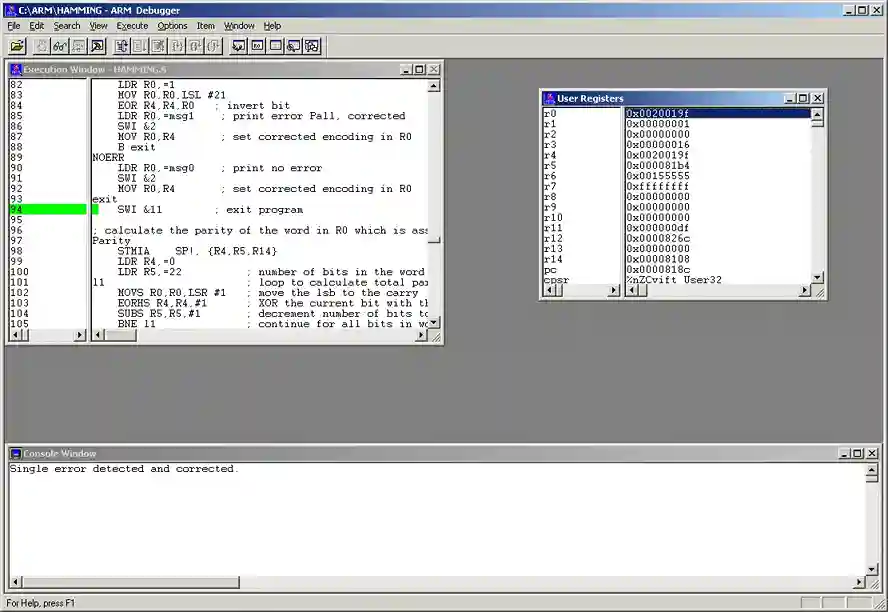The homework deals with correct errors in a word encoded using Hamming code with 16 information bits, 5 parity bits, and a total parity bit. The implementation detects and can correct single-bit errors and can detect double-bit errors and other errors. The program uses a predefined word and tries to detect and correct the single-bit errors using the parity bits. Go through the solution provided below by our ARM assembly homework help solvers and learn how to correct a hamming code error.
Correcting Hamming Code in ARM Assembly

AREA program, CODE
ENTRY
Main
LDR R11,=2_0000000000010011011111 ; word encoded in hamming code as 16 bits data, 5 parity, 1 Pall
AND R0,R11,#0x3F
MOV R0,R0,LSR #1 ; move the 5 parity bits to R0
MOV R1,R11,LSR #6 ; move the 16 data bits to R1
; build the Hamming encoding inserting the parity bits at 2^n positions
LDR R2,=1 ; current power of 2
LDR R3,=1 ; bit counter
LDR R4,=0 ; final hamming encoding
AND R6,R11,#1 ; get Pall in R6
LDR R7,=1 ; current power of 2 for parity
bloop
CMP R3,R7
BNE cpydat ; if the current bit is not a power of 2, skip
AND R5,R0,R2 ; get current parity bit
ORR R4,R4,R5 ; put bit in current bit position
MOV R1,R1,LSL #1 ; shift data bits
MOV R7,R7,LSL #1 ; get next power of 2 for parity
B next
cpydat
AND R5,R1,R2 ; get current data bit
ORR R4,R4,R5 ; put bit in current bit position
MOV R0,R0,LSL #1 ; shift parity bits
next
MOV R6,R6,LSL #1 ; advance Pall to msb
MOV R2,R2,LSL #1 ; get next power of 2
ADD R3,R3,#1 ; increment number of bits
CMP R3,#21 ; continue while we haven't built the 21 bit encoding
BLE bloop
ORR R4,R4,R6 ; add Pall to encoded word
MOV R0,R4
BL Parity ; calculate total parity
MOV R1,R0 ; R1=total parity
LDR R2,=0 ; R2 will contain the 5 parity bits
LDR R7,=4 ; calculate the 5 parity bits
LDR R5,=P0 ; load start address masks in R5
ploop
LDR R6,[R5,R7,LSL #2] ; load bit mask for calculating current P
AND R0,R4,R6 ; select the bits to use for calculating parity
BL Parity ; calculate parity
MOV R2,R2,LSL #1 ; shift old parity bits to the left
ORR R2,R2,R0 ; add current parity bit
SUBS R7,R7,#1
BGE ploop
CMP R2,#0
BEQ NOERR
CMP R1,#0
BEQ DBLERR
ONEERR
LDR R0,=1
shl
SUBS R2,R2,#1
BEQ endshl
MOV R0,R0,LSL #1 ; use R2 to get the erroneous position
B shl
endshl
EOR R4,R4,R0 ; invert erroneous bit
LDR R0,=msg3 ; print single error
SWI &2
MOV R0,R4 ; set corrected encoding in R0
B exit
DBLERR
LDR R0,=msg2 ; print double error
SWI &2
B exit
NOERR1
CMP R1,#0 ;
BEQ NOERR
ERR22 ; error in parity bit
LDR R0,=1
MOV R0,R0,LSL #21
EOR R4,R4,R0 ; invert bit
LDR R0,=msg1 ; print error Pall, corrected
SWI &2
MOV R0,R4 ; set corrected encoding in R0
B exit
NOERR
LDR R0,=msg0 ; print no error
SWI &2
MOV R0,R4 ; set corrected encoding in R0
exit
SWI &11 ; exit program
; calculate the parity of the word in R0 which is assumed to be 22 bits
Parity
STMIA SP!, {R4,R5,R14}
LDR R4,=0
LDR R5,=22 ; number of bits in the word
l1 ; loop to calculate total parity, saving it in R4
MOVS R0,R0,LSR #1 ; move the lsb to the carry
EORHS R4,R4,#1 ; XOR the current bit with the carry
SUBS R5,R5,#1 ; decrement number of bits to process
BNE l1 ; continue for all bits in word
MOV R0,R4 ; return parity
LDMDB SP!, {R4,R5,PC} ; restore registers and return
; positions in encoded word for calculating the parity bits
P0 DCD 2_101010101010101010101
P1 DCD 2_001100110011001100110
P2 DCD 2_110000111100001111000
P3 DCD 2_000000111111110000000
P4 DCD 2_111111000000000000000
msg0 DCB "No error detected.",10,0
msg1 DCB "Error in Pall detected and corrected.",10,0
msg2 DCB "Double error detected, can't be corrected.",10,0
msg3 DCB "Single error detected and corrected.",10,0
END
Similar Samples
Explore our comprehensive library of programming homework samples at ProgrammingHomeworkHelp.com. From Python and Java to specialized topics like Web Development and Assembly Language, each sample demonstrates effective problem-solving and coding techniques. Whether you're a student or professional, our diverse examples offer valuable insights to aid learning and mastery of programming concepts. Browse our curated samples to enhance your skills and excel in your programming assignments.
Programming
Programming
Programming
Programming
Programming
Programming
Programming
Programming
Programming
Programming
Programming
Programming
Programming
Programming
Programming
Programming
Programming
Programming
Programming
Programming
